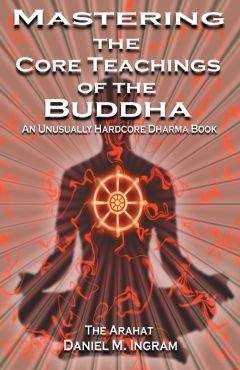Daniel Ingram - Mastering the Core Teachings of Buddha - An Unusually Hardcore Dharma Book
На электронном книжном портале my-library.info можно читать бесплатно книги онлайн без регистрации, в том числе Daniel Ingram - Mastering the Core Teachings of Buddha - An Unusually Hardcore Dharma Book. Жанр: Прочее издательство -, год 2004. В онлайн доступе вы получите полную версию книги с кратким содержанием для ознакомления, сможете читать аннотацию к книге (предисловие), увидеть рецензии тех, кто произведение уже прочитал и их экспертное мнение о прочитанном.
Кроме того, в библиотеке онлайн my-library.info вы найдете много новинок, которые заслуживают вашего внимания.

Daniel Ingram - Mastering the Core Teachings of Buddha - An Unusually Hardcore Dharma Book краткое содержание
Mastering the Core Teachings of Buddha - An Unusually Hardcore Dharma Book читать онлайн бесплатно
This is a bit of an exaggeration, but it makes the point that these ideals are so ingrained in us from many traditions that it is hard to not imagine that enlightened beings must have something remarkable about them that you could feel or see.
Everyone knows that all saints have light coming out of their heads, as did Jesus. You have only to look to medieval paintings to confirm this. The stories of the Buddha are full of his marvelous presence. In fact, his very first interaction with a human after his awakening went something like this. The Buddha had gotten up after exploring the depths of his realization and abilities. He decided to go try to find his five companions who had been with him during his period of grave asceticism, and surveying the world with his psychic powers found they were at Benares. He took off walking down the road between Bodh Gaya and Gaya, and the first person the Buddha talked to after his awakening that wasn’t a god or a giant snake was the monk Upaka. I quote the Buddha as he tells the tale, as rendered in Bhikkhu Ñanamoli and Bhikkhu Bodhi’s The
Middle Length
Discourses of the Buddha ,
Sutta 26, as it is so priceless and such a wealth of information about the origin of these models and ideals:
[Upaka said] ‘Friend, your faculties are clear, the color of your skin is pure and bright. Under whom have you gone forth,
303
Models of the Stages of Enlightenment
friend? Who is your teacher? Whose Dhamma do you
profess?’
I [The Buddha] replied to the Ajivaka Upaka in the stanzas:
‘I am one who has transcended all, a knower of all,
Unsullied among all things, renouncing all,
By craving’s ceasing freed. Having known this all
For myself, to whom should I point as teacher?
I have no teacher, and one like me
Exists nowhere in all the world
With all its gods, because I have
No person for my counterpart.
I am the Accomplished One in the world
I am the Teacher Supreme.
I alone am a Fully Enlightened One
Whose fires are quenched and extinguished.
I go now to the city of Kasi
To set in motion the Wheel of Dhamma.
In a world that has become blind
I go to beat the drum of the Deathless.’
[Upaka replied] ‘By your claims friend, you ought to be the
Universal Victor.’
‘The victors are those like me
Who have won to destruction of taints.
I have vanquished all evil states,
Therefore, Upaka, I am a victor.’
The passage is remarkable in that it sets out a large number of criteria and specifics about what awakening means to the Buddha and to Buddhism in such a short space. Further, what is interesting is the 304
Models of the Stages of Enlightenment number of times the word “I” appears. In fact, “Buddha” means something like Awakened One, or “I am awake.” Thus, we see that the Buddha had no trouble talking about what he had done and who he was, nor did he have trouble thinking the thought “I”.
We note his remarkable presence and skin, and so have the first of the Buddhist Radiance Models and Physical Models. We note that he says he is superior to the Gods, which is sort of a God Model in and of itself, except one better. He describes being free of all the taints and evil states, which is a complex mix of Emotional and Psychological Models.
He also adds the drum of the Deathless, and here we have hints of an Immortality Model or an Extinction Model, and while formally Buddhism would reject both of these associations, aspects of both show up often in the texts anyway. There is also a Transcendence Model, as he says he is unsullied by all things, and also a Specific Knowledge Model, as the Buddha says he is a knower of all. In short, he says he has accomplished something remarkable, and asserts that he is going to go tell others how to do exactly the same thing he did, or is he?
The question of how the Buddha’s realization relates to what he was trying to teacher others is a complex one. There are numerous passages where he says he is quite different from and superior to all other enlightened beings, and draws a clear line between himself and arahats.
Thus, we have to look carefully at what his claims about himself have to do with others, and I devote the whole next chapter to this complex issue. Suffice to say, the problem comes in when the ideals the Buddha discusses as applying to himself, however mythologized we think they are, are applied without careful investigation to enlightened beings of theoretically inferior degree. Then there is the slippery question of the Tibetans who purport to produce full Buddhas in one lifetime…
Back to the issues of whether or not enlightened beings have a special presence. I have seen examples of both, though I suspect that in most cases their presence was largely that way before they started doing spiritual practice. Many people who have asked me questions about practice over the years have hesitantly asked me if there was something remarkable about my presence or how I was able to keep my
realizations hidden at work. I am both sorry and happy to report that I have no problems in this regard at work and as far as I can tell have 305
Models of the Stages of Enlightenment
nothing whatsoever that is unusual about my presence that wasn’t there long before I got into all of this, other than the confidence and passion with which I speak on the dharma. In short, the physical models and radiance are just nice propaganda and another trap that people fall into, both in their own practice and when evaluating the possible level of realization of others.
THE KARMA MODELS
Karma models involve the promise that somehow realization
eliminates, exhausts, cancels out or moderates the forces of causality that would cause bad things to happen to the realized being. Karma involves action and its consequences, and in its simplest form is essentially the statement that causes lead to effects in a lawful way. The subject is imponderable, as the forces and factors involved are so vast and complex that no mind can fully comprehend them. That said, many models and Buddhist ideals subtly or overtly present models of awakening that promise some sort of relief or freedom from adversity.
However, if we look to the life of the Buddha, who by definition is as enlightened as it gets in Buddhism, lots of bad things happened to him, at least according to the texts. He had chronic headaches and back pain, got illnesses, was attacked by bandits, people tried to kill him, his own order broke into warring factions, people harassed him, and so forth and so on. Thus, it is clear that even the Buddha was not free from the laws of karma, and so it would seem naïve to assume that we were also.
However, the karma models raise an interesting question, that of the timing of the fulfillment of the promises of enlightenment and what this has to do with death. The Theravada claims that the moment of complete freedom from suffering is at the death of an arahat or Buddha, as it is only then that there is no more coming into further birth and there is the complete cessation of the senses that cause pain and discomfort. The Tibetans would disagree, focusing on the perpetual life or continued series of rebirths of a Buddha or Bodhisattva throughout time to help awaken other beings. These conflicts bring us to other models, but in fact are paradoxes created by misperception.
However, the karma models are not entirely junk. By seeing each thought, state and emotion as it is, there is an increased ability to simply 306
Models of the Stages of Enlightenment watch these arise and vanish on their own, thus allowing for the causal force of them to not wash through to the future without some moderation of intelligence and wisdom. In this way, past causes, habits, tendencies and the like can be mitigated through clear seeing, and the actions we take based on these that create future causes can be done with more awareness, clarity, and a broader, more inclusive perspective.
This is not the same thing as eliminating all “negative” karma, but it is practical, realistic and verifiable, and thus represents the grain of truth found in the Karma Models.
THE PERPETUAL BLISS MODELS
Perpetual Bliss Models focus on enlightenment bringing on a state of continuous happiness, peace, joy, or bliss. These are commonly found in Hinduism, though they are in full force in Buddhism and other traditions as well, e.g. Christianity’s “the peace that passes all understanding.” Buddhism often describes Nirvana (Nibbana) as synonymous with the highest happiness and the end of suffering, and this end of suffering is the natural corollary of the Perpetual Bliss Models. Perpetual Bliss Models and their corollaries are so pervasive in the world of awakening as to be a central, nearly unassailable tenant of most people’s core beliefs. I am sorry to say, they need serious revision.
The first point is that about impermanence. Bliss, peace, happiness, as well as their counterparts pain, chaos, and misery, are all transient phenomena, subject to conditions, arising and passing like the weather.
As Zen says, the ten thousand joys and the ten thousand sorrows march through our lives according to the laws of reality that have always been in place. This returns us to the great question of realization: does realization change things or does realization reveal how things always were? I advocate a modified version of the latter view, both for practice and for having sane models, but the dogma and those selling something often stray into the promises of a radically different and better existence.
The standard Buddhist argument is that by removing the condition, namely ignorance or misperception, the suffering caused by this condition is also removed. The question then is how much suffering is caused by that particular condition and how much is caused by just being alive. I assert that most of our suffering is caused by simply being alive, but must concede that there is something about changing 307
Models of the Stages of Enlightenment
something in the relationship to the ordinary facts of life and humanity that does help, and why I am so reluctant to admit that there is some sort of peace that comes from realization is a question I am still looking into. While I strongly believe that there are practical reasons not to sell things in this way, I suspect that some residual quirk of my personality is also at play here, and you may have already come to that conclusion.
The other side of the Perpetual Bliss Models is the notion that somehow one will enter into a permanent jhanic state, such as the 4th jhana or some sort of Nibbanic jhana. These versions of the bliss models imply perfect, continuous concentration untouched by
circumstance or enhanced by some sort of inborn wellspring of jhanic qualities. As noted above, all the concentration states are temporary, not related directly to realization, attained both by some who are enlightened and some who are not, and thus are a false promise.
However, as so many people get a taste of jhana and are sure this must just get better and more continuous as they progress, they end up cultivating these states again and again and get nowhere in insight practice. Further, why would someone who was hanging onto a bliss model want to look into suffering? They don’t, and so the chances of them coming into real insight territory or handling the Dark Night well are slim. Now, it is true that there is some sort of relationship between the perspective on things that occurs in the first four jhanas and the four paths, and the panoramic perspective of both the fourth samatha jhana and the panoramic perspective of arahatship share some positive aspects in common, but they are not the same thing, and even mentioning these patterns and parallels is dangerous, as it can cause a lot of misguided effort and assessment of where people are on the path. I think that this is a good place to introduce the Tibetan concept of the Three Kayas, as it has some useful aspects that help make sense of these things.
THE THREE KAYAS
Contrary to what some Tibetan Buddhists would tell you, arahats have a deep understanding of what is meant by their teaching of the Three Kayas or “Bodies of Understanding.” For me, the Three Kayas are very close in meaning and implication to the scopes of the Three Trainings. Arahats understand the fullness of the implications of having been born and of there still being a body and mind (called the 308
Models of the Stages of Enlightenment
“nirmanakaya” or “manifestation body”), relating to training in morality.
All teachings of dependent arising, interconnection and
interdependence fall into the realm of the nirmanakaya.
Arahats know intimately the fullness of the ordinary realities of the human condition: sickness (physical and mental), health, sorrow, joy, conflict, harmony, pleasure, pain, clarity and confusion, stupidity and brilliance. All of these manifest according to the same natural laws that have always been in effect, contrary to popular belief. A body was born and it will get sick and die. The Eight Worldly Winds of praise and blame, fame and ill repute, success and failure, and gain and loss still blow impersonally as always. The laws of biochemistry, physics and physiology still hold. We still have to pay taxes. From a cynic’s point of view, the nirmanakaya is the most disappointing aspect of
enlightenment. Did one really imagine that somehow it would be otherwise? Don’t believe the hype! Another of the great Bill Hamilton one-liners was, “Suffering less, noticing it more.” The more we wake up, the more we notice exactly what it means to have been born.
The nirmanakaya is what is meant by this passage pertaining to the arahat: “The disturbances resulting from the taint of being can no longer be found here, the disturbances related to the taint of attraction can no longer be found here, the disturbances related to the taint of aversion can no longer be found here, and yet there remains the disturbances inherent in these six sense doors that are dependent on a body and conditioned by life”, from Sutta #121, The Shorter Discourse on Voidness, in The Middle Length Discourses of the Buddha. Notice that this says, “six sense doors.” Arahats still think, contrary to occasional myths about “stopping thought”, as noted above. While the content of thoughts is still inherently dual, the true nature of the way thoughts manifest is absolutely non-dual. Arahats know both aspects of thought directly, a bit like being able to see waves on the ocean and yet also that the whole thing is made of water and intimately connected. No wave would ever be fooled into thinking that one wave was watching, controlling, or isolated from another.
The nirmanakaya is also the aspect of understanding that has to do with personality, habits and issues of character. Don’t imagine that just by understanding the full ultimate truth of phenomena that these things 309
Models of the Stages of Enlightenment
will somehow lose their considerable causal inertia. To paraphrase Chi Nul, a great Korean Chan monk, just because the Sun is shining brightly doesn’t mean that all the snow will instantly melt.
On a related theme, the nirmanakaya also relates to the facts of the physiological inertia and biological conditioning of the bodily aspects of the emotional life. The mind of a true arahat is extremely resilient, but the flesh works according to the same laws that were in place before.
Похожие книги на "Mastering the Core Teachings of Buddha - An Unusually Hardcore Dharma Book", Daniel Ingram
Daniel Ingram читать все книги автора по порядку
Daniel Ingram - все книги автора в одном месте читать по порядку полные версии на сайте онлайн библиотеки My-Library.Info.




